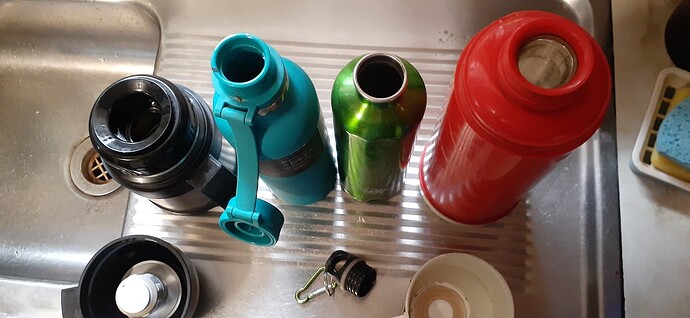I have a Decor “Hydro” insulated double wall drink flask. The label says, “Cold 24 hrs. Hot 10 hrs.”
I filled it and an old vacuum flask with boiling water. Eight hours later the water in the vacuum flask was at 70 degrees C, and the water in the Decor flask was at 50 degrees.
I asked Decor what “Hot 10 hours” merely meant. Decor replied, “The drink bottle will gradually lose temperature during the course of 10 hours; however, it should not be room temperature during this time.”
That reply is effectively meaningless.
A completely uninsulated flask would would gradually lose temperature if it was in a room at 20 degrees, The rate of heat loss would slow as the temperature inside the flask approached the temperature in the room. After 10 hours, the temperature inside the flask would still be above 20 degrees (though the difference might be small).
Choice has done a comparison for you here (member content) that will save you the trouble of doing your own tests. The Decor model tested, which is not the same as yours, came last with a performance score of 3%. Although more expensive than Decor there are brands that score over 90%.
I agree their claims of performance are meaningless but that’s life in this world where anything but outright lies is OK. You will see a lot of talk about such matters in the thread about puffery - although this isn’t an example of that as such we ought to treat vague claims that sound good but promise nothing real the same way; to be ignored.
It sounds nice to say that vendors’ claims ought to be justified by evidence but sadly it is impractical to enforce, so it comes down to caveat emptor.
In just a sealed non-insuarted container the cooling time to room temperature takes about 100 minutes. Not absolutely accurate on the time taken as it depends on the container surface area, construction material, and where it is stored while cooling…
An insulated container will be slower in transferring the energy to or from (if contents of the container are cool) the surrounding environment and will mean that temperatures inside the container will fall or rise slower (if cool going to room temp) than if a non-insulated container was used. How much difference in time will depend on the insulating properties of the insulated container.
There are a number of Laws that can be applied to these problems, but that is going more deeply into the problem than is required.
In the case of the Decor item, it seems they have defined “hot” as a temperature above that of the surrounding environment. For Cold it appears that it means a temperature below the surrounding temp.
An older double walled silvered glass vacuum container is very efficient at reducing energy transference, first there is a vacuum that reduces air contact with the inner wall of the container of the contents thus slowing transference. The level of vacuum will vary the rate of transference as there isn’t a perfect absence of molecules… The major means of transferring energy is by infrared radiation, this is also reduced by the silvering. There are also some small contact points in the bottle that also add to the cooling or heating of the contents.
If the need to have the contents to be substantially hotter or cooler for longer is required/desired then using a glass vacuum container is going to be the best choice. The next best choice then would be one made of metal but still a vacuum container (one with minimal contact between the outer and inner metal linings). If an all metal vacuum container is being used I would also recommend that an insulated sleeve is used to further reduce any heat transference. Often for safety reasons, these days most vacuum containers are made with stainless steel as the glass liners are/were particularly fragile when the container was dropped or bumped. Stanley in Australia probably have the best brand exposure of the insulated vacuum containers, there are others though that compare well.
Hot and cold are relative terms. What Decor are saying is correct as their marketing material doesn’t quantify what is hot nor cold. If they said the bottle maintains (to a specified level) the temperature of the contents of hot fluids for 10 hours/cold fluids for 24 hours then they would be hot water as their product doesn’t meet the product description.
My own comparison, starting with boiling water, yielded the following temperatures after 10 hours:
Decor Hydro insulated double wall drink flask: 54 deg C;
Uninsulated stainless steel bottle: 21 deg C (room temperature);
Old vacuum flask: 73 deg C;
Vacuum soup flask with wide opening: 49 deg C.
It’s marketing BS!
It’s meaningless.
How cold is cold? How hot is hot?
Other similar marketing terms are:-
20% less fat (20% less than what)?
20% off electricity prices (who’s electricity prices)?
50% off (off what)?
How long is a piece of string?
How Long is a Chinese name (this one is true)
The marketing cynic
alias BB
